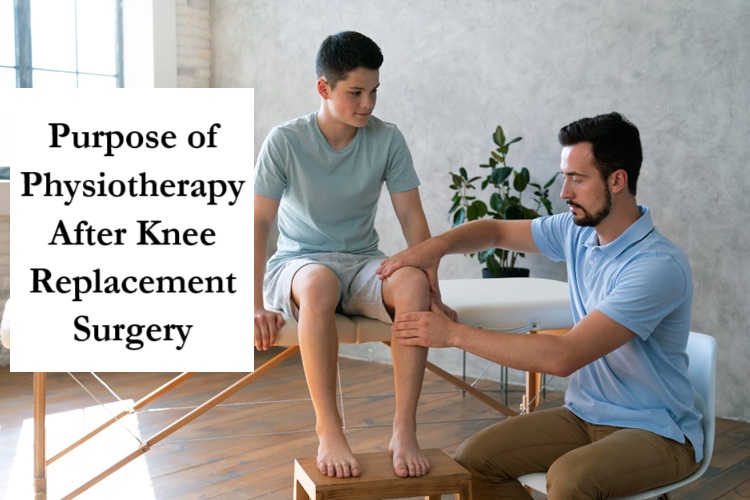
Physiotherapy is crucial in knee replacement surgery. It helps with a patient’s rehabilitation. One can return to an active lifestyle sooner. To learn more about its importance, go through the following post.
Knee Replacement Surgery
People often suffer from debilitating knee pain for various reasons. Arthritis is a strong cause. All knee conditions cannot be treated with rest, medicines, therapies, and other conservative techniques. Thus, surgery becomes the last resort.
Knee replacement surgery is only suggested when the joint is completely damaged internally. The operation only involves resurfacing the damaged parts. During the procedure, durable and safe implant components are used.
This intervention relieves chronic pain. Joint function improves and full mobility is restored. As a result, pain-free steps become the new normal.
Importance & Purpose Of Physiotherapy (PT)
Before knee replacements, patients typically live a sedentary lifestyle due to chronic pain and discomfort while walking. It results in decreased muscle strength. Over time, prolonged inactivity causes the joint to lose its agility.
Thus, after surgery, physiotherapy becomes a must to make weak muscles and soft tissues strong and functional (being able to support bony structures) once again. It is achieved through special exercises, hand-oriented massage techniques and certain stimulation devices.
The intervention also relieves discomfort during recovery by soothing stretching and flexing manoeuvres and joint manipulations. Blood flow increases and promotes healing.
Besides, the physiotherapist informs the patient of potential vulnerabilities, bad choices, and dangers that might lead to complications postoperatively.
Thus, physiotherapy is part of the recovery process (rehabilitation) after a knee replacement.
Causes
Knee replacement surgery is only required when the joint has worn out completely or is damaged severely. It is like giving a fresh life to the knee for the second time. Various conditions can cause knee damage as mentioned below.
Osteoarthritis: Cartilage wears out completely. The bone ends rub against each other while walking. As a result, mobility is reduced badly, leading to physical disability. Osteoarthritis is an age-related condition.
Rheumatoid Arthritis: This is an autoimmune condition. It makes the knee warm, tender, and swollen. Particularly, this happens due to the self-destructive activities of the immune system.
Osteonecrosis: Death of bone tissue due to a lack of blood supply is the condition of osteonecrosis, also known as avascular necrosis. Although it is typically related to the hip ball, the knee joints can also be affected.
Trauma: An injury directly to the knee can cause bad fractures and immobility (physical disability).
Ligament Injuries: The knee has the major four ligaments. Each of them stabilises the joint so it stays in place. Damage to even one ligament leads to instability and severe function-related complications. Without treatment, it leads to knee replacement surgery ultimately.
If you have chronic knee pain, consult a specialist today. Don’t let the condition grow with temporary relief from painkillers. Visit the following link to connect with the right doctor: best orthopedic surgeon in India.
Symptoms
Based on the intensity of knee damage and the prevailing condition, any or all of the following symptoms can manifest.
- Pain
- Stiffness
- Redness
- Tenderness
- Swelling
- Reduced Mobility
- Walking Problems
Diagnosis
The knee conditions can be diagnosed with physical examination and imaging tests such as
- X-ray
- MRI
- CT Scan
Benefits Of Physiotherapy
This therapy has the following benefits or values, which make it crucial during various joint-related medical treatments.
- Muscle Strengthening
- Function Improvement
- Pain Relief
- Injury Prevention
- Non-Pharmacological Intervention
- Improved Performance
- Enhanced Living Standard
A physiotherapist strengthens weak muscles through various exercises, stimulations, manipulations and massages. As a result, muscle volume increases and supports the overall joint. It ultimately improves joint function.
Flexing, manipulating and stretching a joint from various angles increases blood circulation, promotes healing and reduces pain.
The specialist also educates the patient on how to use the knee after surgery or sitting and standing posture techniques. All help prevent possible injuries.
If you are an athlete, physiotherapy will help you recover faster after an injury. It will improve performance as well.
Furthermore, it has no side effects at all, as often associated with prolonged use of painkillers.
Is Physiotherapy Only Used After A Joint Replacement Surgery?
No, it is not true. This therapy is also used even before surgery to boost muscle power and increase tissue density. Preoperative physiotherapy helps enhance surgical outcomes postoperatively.
Certain joint conditions aren’t that severe at all for example Grade 1 sprain or mild stretching, slight injury, strains, etc. These don’t need surgical intervention. Instead, only rest, medicines and physiotherapy help effectively. Thus, for these mild injuries, physiotherapy becomes the main part of treatment and rehabilitation.
As per the condition and the doctor’s call, physiotherapy can be used at any time to offer lasting relief from joint pain and restore the full range of mobility. It can be part of a bigger treatment plan or the complete option in itself.
Conclusion
If you have been suggested knee replacement surgery for chronic knee pain, don’t delay. The knee conditions will worsen over time. It will later impact surgical outcomes. Physiotherapy is used after knee replacements to strengthen muscles and improve joint function for a hassle-free and comfortable return to an active lifestyle.
In short, physiotherapy is a rehabilitation aid or tool after surgery.
To schedule your appointment with the best surgeon, click on the link: best knee joint replacement surgeon in India.





Leave a Reply